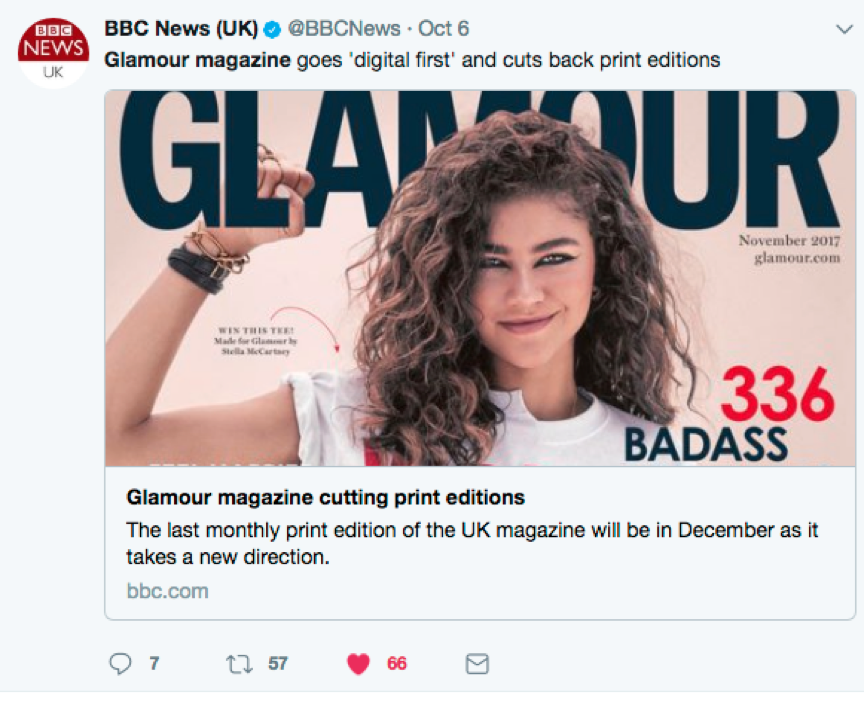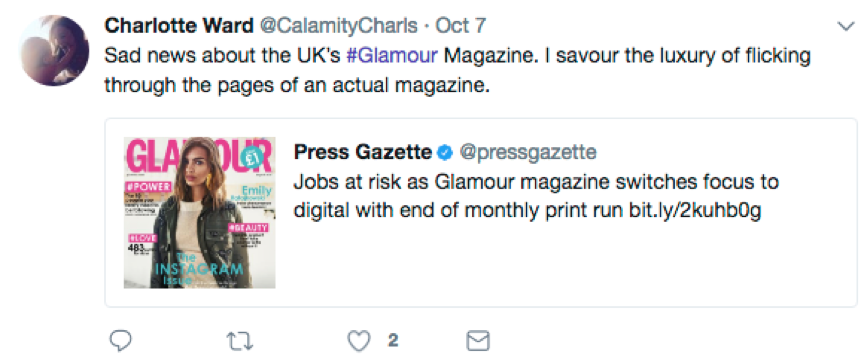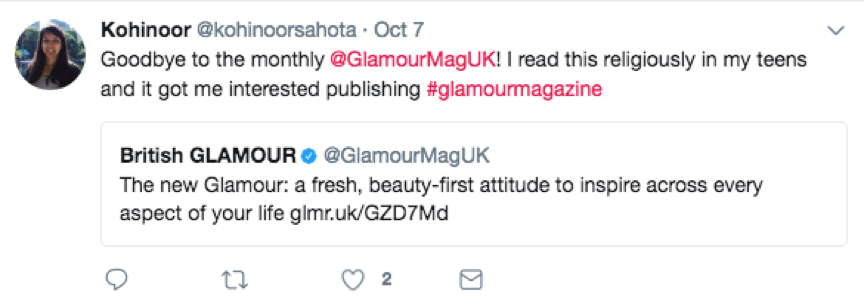Glamour magazine has followed in the footsteps of The Independent, by turning to a digital first strategy - and this news has raised two very interesting points for content marketers to consider.
Since hitting newsstands in 2001, Glamour quickly became the top-selling women’s magazine in the UK. But, as with all publications, it needs to keep up with the times – and from December will axe its monthly print edition and switch to bi-annual publications.

In a statement, it said:
This mobile-first, social-first strategy recognises the way in which the Glamour reader is living their life today, ensuring continued success across multiple platforms.
It was only at the beginning of this year that the magazine scraped its ‘handbag’ size after 15 years, opting for a bigger format that reflects the fact that in a digital age print magazines are now ‘luxurious and indulgent’.
Alongside increasing the size, Glamour, which found that 70% of its online readership came from mobile devices, relaunched its website with a focus on ‘mobile first’.
But, unlike the Independent, the magazine isn’t disregarding print entirely because the new size and pricing strategy has driven a 6% total increase and a 7% rise in UK actively purchased sales period on period.
The news of a drastic change in strategy for Glamour magazine was met with surprise, particularly among readers who have grown up with the popular publication over the last 16 years.

Hannah Gale who left her job at LOOK magazine to become a full time blogger, wrote a post about Glamour. She feels that falling circulation figures will force many publications to die out in the next few years.
She wrote:
All we can do as writers is to continue to keep looking out for trends – what are people reading? What are people sharing? What’s bringing in readers and traffic? And attempt to keep up with the ever changing face of lifestyle journalism by adapting the way we work and the way we package up and distribute our content. Because if one thing’s for sure, nobody’s safe anymore.

Commenting in Diary Directory, Condé Nast Managing Director Albert Read explained:
Today’s Glamour consumer moves to a different rhythm than the one who bought the magazine when it launched in 2001. It is a faster, more focused, multi-platform relationship. The quality of ideas, vision and execution remain central, but the way in which it is delivered must change fundamentally.
What does this show us in content marketing?
This news clearly shows the growing importance of digital, but also points to two important trends for content marketers to be aware of.
Firstly, it is quite clear that the, print vs. digital debate, which has been ongoing for many years, is now over. Digital wins and now comes first. But, in its place is a new debate: can print and digital work together and, if so, how?
Print isn’t dead. Glamour wouldn’t be continuing with two editions a year if it thought it was. But, for publications that handle print and digital output, the print product no longer dominates. It fits in as a secondary partner in the way websites once did when the internet first took off. The debate boils down to where and how print can fit in. Glamour’s bi-annual approach is different and only time will tell if this is the right formula for its brand.
Marketer Emily Pawson, who wrote her university dissertation on the magazine, studied journalism and wanted to work in magazines.
She told Zazzle Media:
I grew up in a generation where magazines were huge. I bought Glamour every single month without fail but now I read everything online, both magazines and blogs. I recognised when graduating that this would slowly become a thing and turned my hand to digital marketing instead of print journalism.
Secondly, we’re starting to see a big role reversal in the market. At Zazzle Media, we talk a lot about ‘Brand as Publisher’ - where brands have to think like the leading magazine for their industry when it comes to their content. Ultimately, moves such as this show the reverse is true. Print publications now have to look at how they can catch up with content marketing and produce digital content that really works.
Instead of brands looking to magazines for inspiration on how to create compelling content, magazines will have to look to leading brands as well as bloggers, vloggers, social influencers and others who have made a success of online content, to determine how they move forward with their digital-first strategy.
It’s a case of convergence. No matter whether your content journey started in print, with a website or on social media, there’s an evolution towards an end result that looks strikingly similar. The fundamentals are the same – people still want to consume the content that made Glamour famous in the first place - the battle is how to find a format and a platform that fits the modern audience.
Sign up for our monthly newsletter and follow us on social media for the latest news.





 Proudly part of IPG Mediabrands
Proudly part of IPG Mediabrands